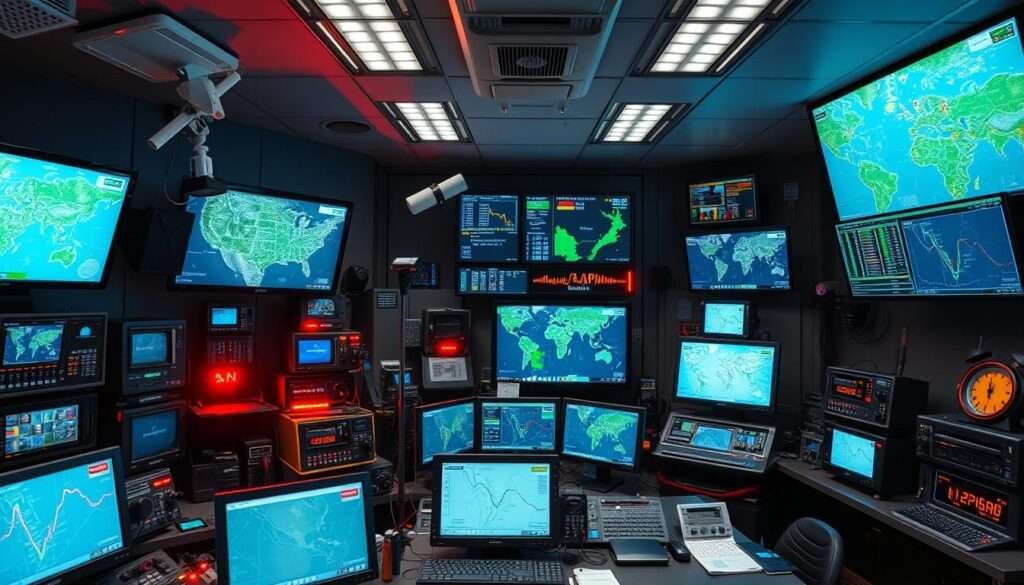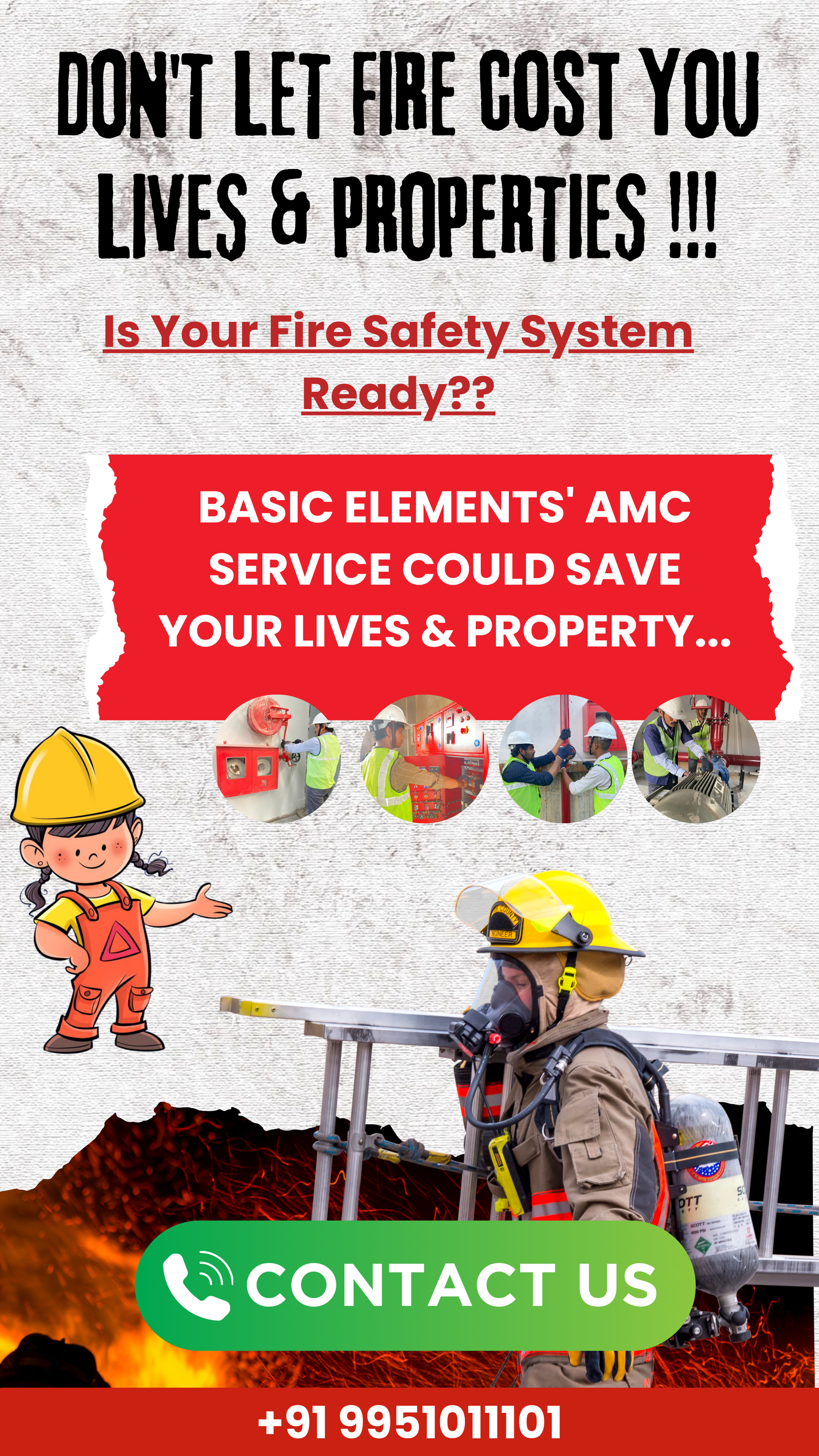Effective emergency communication is key to disaster preparedness and response in India. It helps in sharing information quickly and coordinating efforts during emergencies. This can be the difference between life and death.
In this article, we explore the various emergency communication systems in India. We look at their features, uses, and how they protect lives and property in crises.

Key Takeaways
- Explore the different types of emergency communication systems, including mass notification systems, emergency broadcast systems, fire safety communication systems, and early warning systems.
- Understand the importance of two-way radio communication systems and panic button/duress alarm systems in emergency response.
- Learn about the significance of interoperability and the integration of emergency communication systems with existing infrastructure.
- Discover the regulatory compliance and industry standards that govern the deployment and maintenance of these critical systems.
- Gain insights into best practices for effective emergency communication, ensuring a safer and more resilient India.
Introduction: Safeguarding Lives with Effective Emergency Communication
In times of crisis, quick and reliable emergency communication can save lives. These systems are key to protecting people, property, and coordinating crisis responses. By knowing about different emergency communication technologies, we can prepare our communities for emergencies.
Emergency communication includes systems like mass notifications and two-way radios for first responders. These solutions help keep people safe, protect property, and make crisis responses more efficient. We will look at the various emergency communication systems, their abilities, and how they work together to prepare for emergencies.
| Emergency Communication System | Key Capabilities | Application |
|---|---|---|
| Mass Notification Systems | Rapid dissemination of critical information to the public | Alerting residents of emergencies, providing instructions, and coordinating evacuation efforts |
| Emergency Broadcast Systems | Interrupting regular programming to deliver urgent messages | Informing the public about imminent threats, such as severe weather, natural disasters, or other emergencies |
| Fire Safety Communication Systems | Dedicated communication channels for fire departments and building occupants | Enhancing fire response coordination and enabling real-time updates during fire emergencies |
“Effective emergency communication is the foundation of a resilient and prepared community.”
Types of Emergency Communications Systems
In times of crisis, it’s vital to have effective emergency communication. This helps keep people safe and helps in coordinating responses. There are mainly two types: mass notification systems and emergency broadcast systems.
Mass Notification Systems
Mass notification systems send urgent alerts through many channels. These include text messages, email, social media, and public address systems. They aim to quickly share critical information with many people.
This way, everyone knows what’s happening and can act fast. By using different platforms, these systems can reach a lot of people. This makes emergency messaging more effective.
Emergency Broadcast Systems
Emergency broadcast systems use old media like radio and TV to share emergency info. They work with government alert networks to send out updates quickly. These systems are key in keeping the public informed during emergencies.
They provide important instructions and updates. This helps keep people safe and informed during crises.
| Feature | Mass Notification Systems | Emergency Broadcast Systems |
|---|---|---|
| Communication Channels | Text messages, email, social media, public address systems | Radio, television |
| Targeted Audience | Specific groups or large populations | General public |
| Information Delivery | Rapid, real-time updates | Widespread, traditional media dissemination |
| Interoperability | Integrates with various communication platforms | Relies on established government-run alert networks |
“Effective emergency communication is the backbone of a successful crisis response. By leveraging both mass notification systems and emergency broadcast systems, we can ensure that critical information reaches the right people at the right time, ultimately saving lives and minimizing the impact of emergencies.”
Fire Safety Communication Systems
In emergency preparedness, fire safety communication systems are key. They protect lives and reduce damage. These systems include fire alarms, smoke detectors, sprinklers, and emergency alerts.
They work with communication networks to save lives. Advanced tech detects fires, alerts people, and guides responders. This ensures a quick and effective response.
Fire alarm panels are at the center of these systems. They get signals from sensors and devices. This triggers alarms and safety features.
Smoke detectors are the first to spot smoke. They send signals to the fire alarm panel. This alerts everyone to the danger.
Emergency notification devices like strobes and horns alert people. They give clear instructions for safety and evacuation.
By linking fire safety systems with emergency networks, safety improves. This helps first responders act fast. It saves lives and reduces damage.
“Effective fire safety communication systems are the backbone of any comprehensive emergency preparedness plan. They empower us to respond swiftly and decisively, minimizing the risk to human life and property.”
Early Warning Systems: A Lifeline in Emergencies
Early warning systems are key to keeping our communities safe. They give us the info we need for emergencies, like natural disasters. Outdoor warning sirens and emergency alert systems (EAS) are among the most important tools.
Outdoor Warning Sirens
Outdoor warning sirens alert us to dangers like severe weather. They’re placed in neighborhoods and towns to quickly tell us to seek shelter. Listening to these sirens helps us prepare for disasters and stay safe.
Emergency Alert Systems (EAS)
Emergency alert systems (EAS) send updates through radio, TV, and wireless alerts. They help us get critical info fast, so we can act quickly in emergencies.
Using these systems shows our dedication to being ready for disasters. By listening to these alerts, we protect our families and communities. This makes our future stronger and safer.
“Early warning systems are the unsung heroes of emergency response, providing us with the precious time we need to protect ourselves and our loved ones.”
Two-Way Radio Communication Systems
Two-way radio systems are key in emergency communication. They help first responders and emergency teams talk clearly and quickly. This is crucial for sharing important info and instructions during emergencies.
Portable Radios
Portable radios are essential for emergency teams. They are small, light, and simple to use. This makes them perfect for moving around in cities or reaching far-off places.
These devices keep teams connected. They help coordinate efforts and respond fast to emergencies.
Base Stations and Repeaters
Base stations and repeaters are vital for wider coverage. Base stations are the main centers for sending and receiving signals. Repeaters boost these signals, making them stronger.
This setup lets emergency teams talk clearly over long distances. It’s especially useful in hard-to-reach areas.
“Two-way radio communication systems are the backbone of emergency response, providing a reliable and resilient platform for seamless coordination and information exchange.”
Portable radios, base stations, and repeaters keep emergency teams connected. They help coordinate actions and respond quickly to emergencies. These systems are key to a good emergency communication plan. They help save lives and manage crises well.
Panic Button and Duress Alarm Systems
In today’s fast world, keeping safe and secure is key. Panic button and duress alarm systems help a lot. They let people call for help quickly and quietly, helping to keep everyone safe.
Panic buttons are easy to find, like at desks or counters. Pressing them sends out an alarm fast. Duress alarms are more hidden, letting people signal for help quietly.
| Feature | Panic Button | Duress Alarm |
|---|---|---|
| Activation | Prominent, easy-to-reach button | Discrete, hidden button or switch |
| Purpose | Immediate notification of an emergency | Discreet signaling of a threat or duress situation |
| Typical Use Cases | Retail stores, banks, schools, hospitals | High-risk workplaces, law enforcement, security personnel |
Adding panic and duress alarms to safety plans makes a big difference. It helps keep people safe at work and in public places. These systems are key for quick help in emergencies.
“The ability to quickly and discreetly call for help can make all the difference in an emergency situation.”

New tech makes these alarms even better, with features like tracking and remote monitoring. This helps keep communities safe and ready for emergencies.
Interoperability: The Key to Seamless Emergency Response
In emergency response, interoperability is key. It makes different communication systems work together. This helps share important information and coordinate actions during crises.
By ensuring interoperability, we improve emergency management. This helps save lives and protect communities.
Interoperability is more than just technology. It’s about working together. When systems can share data easily, everyone can make better decisions. This is crucial in emergency situations.
It ensures resources are used well. And important information gets to those who need it.
The benefits of interoperability are many. It helps everyone understand the situation better. It also makes sure everyone has the same information.
In the end, it builds a team spirit. Agencies work together to protect people and communities.
| Interoperability Advantages | Impact on Emergency Response |
|---|---|
| Seamless information sharing | Improved situational awareness and coordinated actions |
| Unified command and control | Efficient resource allocation and deployment |
| Enhanced cross-agency collaboration | Streamlined decision-making and emergency management |
As we face the challenges of modern emergency response, interoperability is vital. It makes sure our systems work together well. This shows our strong commitment to keeping everyone safe.
“Interoperability is not just a technical solution, but a strategic imperative that demands collaboration and a shared vision for effective emergency response.”
Integrating Communication Systems with Existing Infrastructure
To improve emergency response, we need to link emergency systems with our buildings. This means using building management and security systems. Together, they make emergency plans stronger and more organized.
Building Management Systems
Building management systems (BMS) control important building functions like HVAC and security. When emergency systems are linked with BMS, they work better in crises. This setup allows for quick, remote control and monitoring, making emergency actions faster and more effective.
Also Read: Fire Safety Guidelines for Schools in India
Access Control and Security Systems
Access control and security systems keep our buildings safe. By connecting emergency systems with these, we boost our emergency readiness. For instance, in an emergency, the system can lock doors or alert security, helping us respond better.
By combining emergency systems with building and security systems, we get a strong, integrated system. This system improves our emergency readiness and safety. It ensures our buildings are ready to protect us in emergencies.

Maintenance and Testing of Emergency Communication Systems
Keeping emergency communication systems reliable and resilient is key. Regular maintenance and testing make sure these systems work when we need them most. This is crucial during emergencies.
Proper maintenance includes several steps:
- Routine inspections to find and fix problems
- Regular servicing and maintenance to prevent issues
- Updating software and firmware to keep systems current
- Testing backup power sources to ensure systems keep running
Testing these systems is just as important. It checks if they work well together and if they can reach everyone who needs to know. This includes:
- Running drills and simulations to test system performance
- Checking how different parts of the system communicate
- Verifying that mass notifications and sirens can reach everyone
- Ensuring emergency alerts are sent out quickly and correctly
By focusing on emergency communication system maintenance and system testing, we can make our emergency plans better. This helps keep people safe and ensures we can respond well in emergencies.
| Maintenance Task | Frequency |
|---|---|
| Inspect system components | Monthly |
| Perform preventative maintenance | Quarterly |
| Update software and firmware | Biannually |
| Test backup power sources | Annually |
“Maintaining the resilience and operability of emergency communication networks is a critical aspect of emergency preparedness and crisis response.”
Regulatory Compliance and Industry Standards
Keeping up with regulatory compliance and industry standards is key for emergency communication systems to work well. In India, these systems must follow rules from various bodies and groups. This ensures public safety and keeps systems running smoothly.
NFPA Codes and Standards
The National Fire Protection Association (NFPA) is a top name in fire safety and emergency response in India. NFPA codes and standards give detailed advice on fire safety and emergency communication systems. They cover many areas, like fire alarm systems and emergency lighting, making sure systems work well together.
FCC Regulations
The Federal Communications Commission (FCC) in India looks after radio frequencies and communication gear, including for emergencies. FCC rules make sure two-way radios, used by first responders, are properly licensed and work well. Following FCC standards is vital for clear and reliable communication in emergencies.
| Regulatory Body | Focus Area | Key Regulations |
|---|---|---|
| National Fire Protection Association (NFPA) | Fire safety and emergency communication systems | NFPA 72, NFPA 1221, NFPA 1600 |
| Federal Communications Commission (FCC) | Radio frequency and communication equipment | FCC Part 90, FCC Part 22 |
Following these rules and standards helps emergency communication systems work well and safely. This boosts India’s emergency response abilities.

Best Practices for Effective Emergency Communication
Creating a solid emergency communication plan is key to keeping people safe and reducing crisis damage. By following the best practices, groups can make their emergency systems work better. This helps them serve their communities well. Here are some important tips:
Develop Comprehensive Emergency Communication Plans
Make detailed emergency plans that cover all scenarios. They should list who does what and how. Update these plans often to keep them useful.
Train Personnel on System Operations
Teach those who use emergency systems how to do it right. Make sure they know how these tools work and how to keep them running.
Conduct Regular Drills and Exercises
Test emergency systems often with drills. This checks if they work well and finds ways to get better. It keeps everyone ready for real emergencies.
Engage the Community
Work closely with the community through education. Teach people about emergency channels and why being ready is important.
| Best Practice | Benefits |
|---|---|
| Comprehensive Emergency Communication Plans | Streamlined response, clear roles and responsibilities |
| Personnel Training | Improved system operation, enhanced readiness |
| Regular Drills and Exercises | Identification of vulnerabilities, continuous improvement |
| Community Engagement | Increased awareness, improved public safety |
By following these tips, groups can improve their emergency communication best practices. They can get better at being ready for emergencies. This helps keep everyone safe and builds a stronger community.
“Effective emergency communication is the cornerstone of a resilient community. By embracing best practices, we can empower our citizens and save lives when it matters most.”
Conclusion: Embracing Robust Emergency Communication for a Safer Tomorrow
Emergency communication systems are key in today’s world. They help us stay safe in many situations. By using the right tech, like mass notifications and two-way radios, we can make our communities stronger and safer.
Connecting these systems with what we already have, like building management, makes things work better. It’s important to keep these systems up to date and tested. This ensures they work well when we need them most.
By following the best ways to use emergency communication, we can help our communities get ready for emergencies. This way, we can all stay safe and sound, thanks to good communication systems.
FAQ
What are the key types of communication systems?
There are several types of emergency communication systems. These include mass notification systems and emergency broadcast systems. Fire safety communication systems and early warning systems like outdoor warning sirens are also important. Two-way radio communication systems and panic button/duress alarm systems are key too.
How do fire safety communication systems help save lives during emergencies?
Fire safety systems use fire alarm panels, smoke detectors, and sprinkler systems. They also have emergency notification devices. These systems give early warnings, help with evacuation, and coordinate emergency responses. They work with emergency networks to save lives and reduce damage during fires and emergencies.
What is the importance of interoperability in emergency communication systems?
Interoperability is key for effective emergency response. It means different systems can work together smoothly. This makes crisis management more efficient. It helps first responders, authorities, and the public work together better during emergencies.
How can emergency communication systems be integrated with existing building infrastructure?
Integrating emergency systems with building management and security systems improves emergency response. These systems can monitor and control critical functions and access points during crises. This makes buildings safer and more resilient.
What are some best practices for maintaining and testing emergency communication systems?
Keeping emergency systems in good shape is crucial. Regular checks and tests ensure they work when needed. This helps identify and fix issues before emergencies happen. It’s vital for emergency preparedness and response.
Emergency systems must follow rules and standards for safety and effectiveness. In India, NFPA codes guide fire safety and emergency systems. The FCC ensures two-way radios are used correctly in emergencies. These rules help keep everyone safe.







